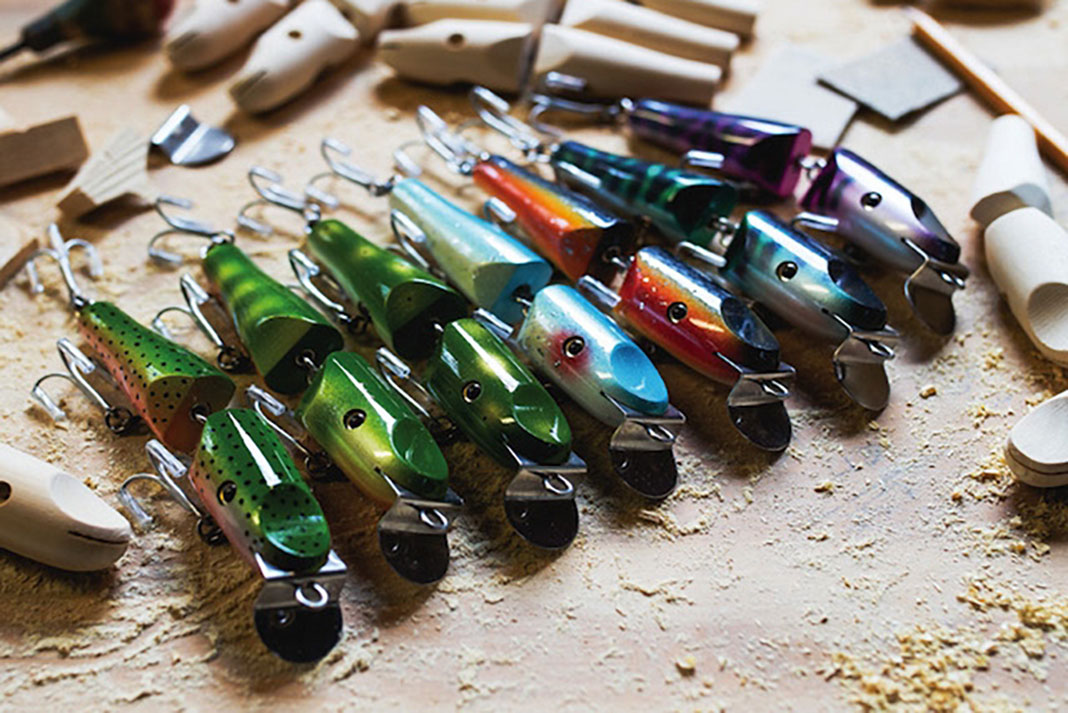
L arry Wentworth knows a few things about wooden fishing lures and using his creations to catch incredible amounts of fish. Wentworth, also known as “Big Fish Larry,” is the proprietor and creative force behind BigFish Bait Company, a builder of traditional wooden lures. Prior to that, he was a hobbyist and angler who fished his own plugs. We caught up with Big Fish Larry and other lure-making experts to get their insights on the craft and see how they broke into the biz.
Before his wooden creations became more than a personal hobby, Larry recounts a story where schools of striped bass and bluefish were driving menhaden into the shorebreak. “I caught 35, maybe 40 fish, I lost count,” he recalls, “some of the striper were over 25 pounds.” Even better, he caught the fish on a lure that he built in his garage.

Wooden lure making is a long tradition in the Northeast. Surf anglers have been tinkering with swimmers, poppers and needlefish since the Second World War. What started as a way to build tougher, stronger and bigger lures for striped bass, bluefish and red drum, turned into an art and even a business for the most talented builders. Now, Wentworth and other innovators are taking the techniques and designs to kayak fishing and freshwater species. Wentworth has modified time-tested striper lures to target largemouth bass.
“I’ll make the lure smaller, or reposition the weight until I get it perfect.” The seven- to nine-inch striper lures can weigh up to four ounces, so Wentworth makes his patterns smaller to target freshwater species. “The one-ounce pencil popper is a fish-slayer in the kayak,” he says, “the smaller size is easier to cast and work when I’m sitting low to the water.”
Lure maker and kayak angler, Ryan Smith loves to modify his designs to match the current bait scenario. Some years the striped bass are feeding on large bunker. “I’ll whip up some Dannys or Giants,” he says. Other times, big bass are eating sand eels or anchovies. “I’ll answer with a needlefish or a smaller swimmer.” Even after the lure is finished, Smith can tune it by bending the lip or line-tie to make the plug dive deeper or wobble harder. Smith can even tune a casting plug to troll out of his kayak.
Most wooden plugs are carved out of Alaskan yellow cedar, which is naturally buoyant and water resistant. Then the wood is stained or painted and sealed. Wentworth and Smith airbrush wild patterns and colors on their plugs. “Mostly to catch anglers,” Wentworth jokes, “you can get started with a couple cans of spray paint.” It only takes a table lathe and a few basic tools to get in the game.
“You can even hand-carve lures,” Wentworth adds. He recommends a bench-mounted drill press to run internal components. Hooks and hardware can be ordered through tackle supply companies and countless blogs and forums are dedicated to the art and skill of wooden lure making. There are even clubs and swap meets. “I get together with other plug builders and go fishing all the time,” Wentworth says, “there’s a culture of lure makers.”
What started as a way to save a few bucks turned into a way to make a few bucks for these anglers. “I ended up quitting my day job and going full-time into lure building,” Smith says. Now he sells lures through the mega-forum Stripers Online. Wentworth also turned his hobby into a business. “Before I knew it my plugs were in stores from Jersey to Maine.”
For most anglers, making wooden fishing lures is only a hobby—a hobby that can pay off on the water. “Catching a fish on your own plug is a rush,” Wentworth buzzes, “it never gets old.”
This article was first published in the Summer/Fall 2015 issue of Kayak Angler Magazine. Subscribe to Kayak Angler Magazine’s print and digital editions, or browse the archives.
Freshly painted wooden fishing lures by Larry Wentworth are laid out ahead of pieces awaiting assembly and detailing. | Feature photo: Courtesy of Larry Wentworth